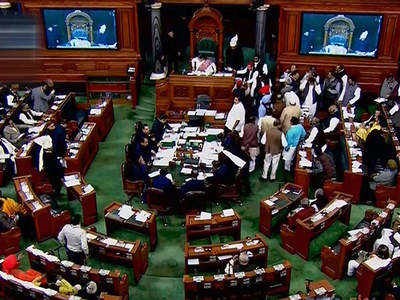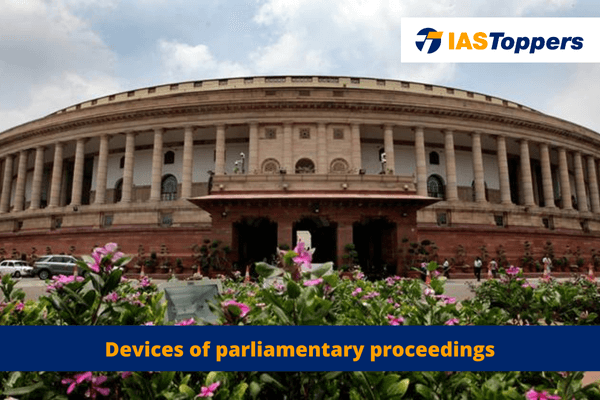Devices of parliamentary proceedings ranges from Question Hour, Zero Hour, Motions, Point of Order, Half-an-Hour Discussion, Short Duration Discussion, Special Mention and Resolutions. In this article, you will learn about the various devices of parliamentary proceedings such as Question Hour, types of Motions, various Resolutions and its features, providing key insights for GS Paper-II Polity and Governance section of UPSC IAS Exam.
In this article, you will know all about Devices of parliamentary proceedings relevant to GS-Paper II of UPSC Civil Service Mains Examination.
Table of Content
- What are various devices of parliamentary proceedings in India?
- Features of the Question Hour:
- Features of the Zero Hour:
- Features of the Motions:
- Features of the Point of Order:
- Features of the Half-an-Hour Discussion:
- Features of the Short Duration Discussion:
- Features of the Special Mention:
- Resolutions:
- Conclusion
- Frequently Asked Questions
- Reference
What are various devices of parliamentary proceedings in India?
- Various devices of parliamentary proceedings are: Question Hour, Zero Hour, Motions, Point of Order, Half-an-Hour Discussion, Short Duration Discussion, Special Mention and Resolutions.

Features of the Question Hour:
- It is the designated first hour of every parliamentary sitting.
- It allows members to ask questions, and ministers typically provide their answers.
- 3 types of questions can be asked to the ministers- starred, un starred, and short notice.
- Starred questions require an oral answer and permit supplementary questions.Un starred questions require a written answer and do not permit supplementary questions.
- Short notice questions must be asked with less than ten days’ notice and are answered orally.
- Ministers and private members can be questioned on matters related to their responsibilities.
- The procedure for questioning private members is similar to that for ministers.
- These questions are printed in different colors– green, white, light pink, and yellow to distinguish their types.
Features of the Zero Hour:
- It is not officially mentioned in the Rules of Procedure.
- It follows the Question Hour immediately as per the convention and lasts until the agenda for the day is taken up.
- It provides an opportunity for members to raise matters without prior notice.
- It is Indian innovation introduced in 1962.
Features of the Motions:
- It plays a crucial role in discussions of matter of general public importance.
- The House expresses its decisions through the adoption or rejection of motions as presented by ministers or private members.
- 3 types of motions:
- Substantive Motion: it is an independent proposal to address significant matters such as the impeachment of the President or removal of the Chief Election Commissioner.
- Substitute Motion: it replaces an original motion and offers an alternative.
- If adopted, the substitute motion supersedes the original one.
- Subsidiary Motion: it cannot state the House’s decision without reference to the original motion or House proceedings.
- It consists of ancillary motions, superseding motions, and amendments.
Closure Motion:
- It allows a member to end the debate on a particular matter.
- 4 types of closure motions: simple closure, closure by compartments, kangaroo closure, and guillotine closure.
- Simple closure: when a member moves that the ‘matter having been sufficiently discussed be now put to vote’.
- Closure by Compartments: the clauses of a bill or a lengthy resolution are grouped into parts before the debate but the entire part is put to vote.
- Kangaroo Closure: only important clauses are debated and voting and the intervening clauses are skipped and deemed as passed.
- Guillotine Closure: when the undiscussed clauses of a bill or a resolution are put to vote along with the discussed clauses due to less time available.
Privilege Motion:
- It is used to address breaches of parliamentary privileges by a minister.
- Members can move this motion if they believe that a minister has withheld or distorted facts in order to censure the concerned minister.
Calling Attention Motion:
- It allows a member to draw the attention of a minister to an urgent matter of public importance and request an authoritative statement.
- It is mentioned in the Rules of Procedure.
- It is Indian innovation introduced in 1954.
Adjournment Motion:
- It highlights a specific matter of urgent public importance involving an element of censure against the government.
- The Rajya Sabha is not permitted to use this motion.
- It requires support from 50 members for admission.
- It disrupts the regular business of the House.
- Its discussion should last for not less than two hours and thirty minutes.
- Restrictions to raise it:
- The matter raised should be specific, based on facts and of urgent public importance.
- Only one matter should be addressed, without covering multiple topics.
- The discussion should be focused on a recent occurrence and avoid generalizations.
- It should not pertain to a question of privilege.
- The same session should not revisit a matter that has already been discussed.
- It should not involve any matter currently being decided in court.
- The question raised should not be suitable for a separate motion.
No-Confidence Motion:
- It can be passed by the Lok Sabha to remove the council of ministers if they lose the confidence of the house.
- Article 75 of the Constitution states that the council of ministers shall be collectively responsible to the Lok Sabha.
- This motion requires the support of 50 members to be admitted.
Confidence Motion:
- It is a procedural device used in case of fractured mandates, hung parliaments, minority governments, or coalition governments.
- It need not state the reasons for its adoption in the Lok Sabha.
- It allows the government to prove its majority and gain the confidence of the House.
- If the motion is rejected, the government falls.
Censure Motion:
- It is moved for censuring the council of ministers for specific policies and actions along with the reasons for its adoption in the Lok Sabha.
- It can be moved against an individual minister or a group of ministers or the entire council of ministers.
- If it is passed in the Lok Sabha, the council of ministers need not resign from the office.
Motion of Thanks:
- After each general election and at the beginning of every fiscal year, the president addresses the first session.
- In this address, the president outlines the government’s policies and programs for the previous and upcoming years.
- It is similar to the “speech from the Throne” in Britain.
- The address is discussed in both Houses of Parliament through a motion called the “Motion of Thanks.”
- The motion is then put to vote after the discussion and must be passed.
- Its rejection signifies the government’s defeat.
- The speech provides an opportunity for Members of Parliament to raise discussions and debates to examine and criticize the government’s shortcomings and failures.
No-Day-Yet-Named Motion:
- It is a motion that has been accepted by the Speaker but has not yet been assigned a date for discussion.
- The Speaker in accordance with the House’s business and in consultation with the leader of the House or the Business Advisory Committee, schedules days for discussing such a motion.
Dilatory Motion:
- It is used to adjourn the debate on a bill, motion, resolution, etc., or to slow down the progress of ongoing business in the House.
- It can be moved by any member after a motion has been made.
- The debate on a dilatory motion should be limited to the matter stated in the motion.
- If the Speaker determines that the motion is an abuse of the House’s rules, they may either immediately put the question to vote or decline to propose the question.
Features of the Point of Order:
- A member can raise a point of order when the House’s proceedings deviate from the normal rules of procedure.
- It must be related to the interpretation or enforcement of the House’s rules or articles of the Constitution that regulate its business.
- It should raise a question that falls within the Speaker’s jurisdiction.
- Typically, opposition members raise points of order to hold the government accountable.
- It temporarily suspends the House’s proceedings.
- No debate is allowed on a point of order.
Features of the Half-an-Hour Discussion:
- It aims to address a matter of significant public importance that has already been extensively debated but requires clarification on factual aspects.
- The Speaker can allocate 3 days per week for such discussions.
- There is no formal motion or voting during these discussions.
Features of the Short Duration Discussion:
- It is also known as a two-hour discussion as the time allocated for this discussion should not exceed two hours.
- The Speaker can allocate two days per week for discussions on a matter of urgent public importance when raised by any member.
- There is no formal motion or voting involved.
- This procedural device has been in place since 1953.
Features of the Special Mention:
- It is raised when any matters do not qualify as a point of order or cannot be raised during question hour, half-an-hour discussion, short duration discussion, adjournment motion, or calling attention notice.
- It is device of the Rajya Sabha.
- It is similar to the ‘Notice (Mention) Under Rule 377’ in the Lok Sabha.
- It provides an opportunity to bring up such matters in the House.
Resolutions:
- Members can propose resolutions to draw the House’s or the government’s attention to matters of general public interest.
- The discussion on a resolution must strictly pertain to and be within the scope of the resolution.
- A member who has proposed a resolution or an amendment to a resolution cannot withdraw it without the House’s permission.
- 3 categories: Private Member’s Resolution; Government Resolution and Statutory Resolution.
- Private Member’s Resolution: Proposed by a non-minister member, this type of resolution is only discussed on alternate Fridays during the afternoon sitting.
- Government Resolution: Proposed by a minister, this type of resolution can be taken up any day from Monday to Thursday.
- Statutory Resolution: Proposed by either a private member or a minister and tabled always in accordance with a provision in the Constitution or an Act of Parliament.
Difference between resolutions and motions:
| Resolutions | Motions |
| All resolutions fall under the category of substantive motions, meaning that every resolution is a specific type of motion. | Not all motions are necessarily substantive. |
| All resolutions must be put to a vote. | Not all motions require a vote in the House. |
Conclusion
The devices of parliamentary proceedings play a vital role in the proper functioning of democratic institutions by facilitating discussions, addressing public concerns, and promoting the values of democracy, transparency, and accountability. These devices ensure that diverse perspectives are heard and deliberated upon in the legislative process.
Ref: Source-1
FAQs (Frequently Asked Questions)
What are various devices of parliamentary proceedings?
Various devices of parliamentary proceedings are Question Hour, Zero Hour, Motions, Point of Order, Half-an-Hour Discussion, Short Duration Discussion, Special Mention and Resolutions.
What do you mean by Question Hour?
It is the designated first hour of every parliamentary sitting which allows members to ask questions, and ministers typically provide their answers.
What are different type of Motions?
Substantive Motion, Substitute Motion, Subsidiary Motion, Closure Motion, Privilege Motion, Calling Attention Motion etc.


